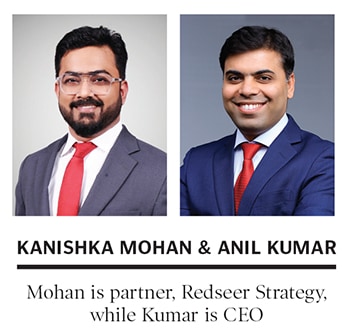$1 trillion market cap not just a possibility but a vision for future of startup
Kanishka Mohan, partner, and Anil Kumar, CEO of Redseer Strategy write about how startups can fuel the public markets


T he year 2021 was great for Indian startups with record private investments and a whirlwind of public listings. Despite the slowdown in the velocity of IPOs in the subsequent years, we believe this marks the beginning of a wave of upcoming new-age IPOs. We are at the beginning of stage one of a flywheel which is changing the way domestic and international investors view India as a key investment destination.
he year 2021 was great for Indian startups with record private investments and a whirlwind of public listings. Despite the slowdown in the velocity of IPOs in the subsequent years, we believe this marks the beginning of a wave of upcoming new-age IPOs. We are at the beginning of stage one of a flywheel which is changing the way domestic and international investors view India as a key investment destination.
Now that Indian public bourses are at an all-time high and volatility is low, listing activity has regained momentum. This resurgence encompasses a diverse range of companies, including established SMEs, marquee companies, and crucially, a wave of promising new-age startups.
However, it’s essential to recognise that new-age tech companies, while promising, represent a fraction of the overall market capitalisation. Indian tech market cap is dominated by the so-called WITCH companies. The situation is different in the US, where the FAANG companies represent new-age business models that extend far beyond traditional IT services. Additionally, the US boasts a well-developed ecosystem that fosters successful startup exits through acquisitions and public listings.
2021 was particularly favourable for new-age IPOs. Coming in with a phenomenal uptick in digital activity (fuelled by Covid-19 lockdowns), Indian startups raised a record high of $42 billion. Riding the market euphoria, pioneers such as Zomato, Paytm, Nykaa, Delhivery and others listed successfully near their private market valuations.
The first wave of new-age listings got one crucial aspect right: Timing. However, these early entrants faced challenges in sustaining the attention of public investors who prioritised business fundamentals over a promising narrative. New-age stock prices fell below their IPO benchmark and have taken almost three years to recover. There were clear lessons for the next set of startups thinking about listing. An ‘IPO-ready’ company must focus on:
Today, many new-age startups have matured and grown into their private valuations. Case studies such as Zomato have created a playbook for aspiring IPO candidates. When Zomato first listed, they carried significant bloat in the form of high marketing and expensive initiatives. With a ruthless focus on only successful initiatives (Hyperpure and successful integration of BlinkIt), the stock has managed to surpass IPO pricing. Key takeaway: Going public is not the finish line, but rather the beginning of a new chapter that demands a continued focus on growth and profitability.
The future of India’s public markets looks promising, largely driven by upcoming new-age IPOs.
The Indian startup ecosystem has matured rapidly in the last five years. There are more than 100,000 startups, even as investors have doubled in the last five years. India boasts over 100 unicorns—startups valued at over $1 billion—third globally. More importantly, startups are now prioritising profitability rather than chasing growth—a sign of maturity for the ecosystem.
Redseer analysis suggests that, compared to 2021, 50 percent more companies are now profitable or are on the path to profitability. Notably this trend is true even at the early stages. Startups are leveraging alternative marketing, improved assortment and lean organisations to reduce cash burn. Corporate governance has also improved across the board, with fewer reports of implosions.
We expect over 150 new-age IPOs over the next five to six years. Consumption-driven goods and services (ecommerce, platforms, brands, etc), fintech and SaaS will comprise less than 50 percent of the listings. A significant proportion of these listings will be issues of more than $100 million.
As the Indian economy maintains a growth trajectory of more than 6 percent, the public markets will keep pace and new-age market cap will represent $1 trillion market cap by 2033, representing 8 to 10 percent of the overall market cap.
Driving this momentum is the flywheel between private and public markets. As new-age startups list successfully, private equity will generate returns and feed it back into the private markets, encouraging more companies to go public. At the same time, new-age stock will attract more analyst coverage, providing investors with valuable insights and transparency.

There’s a significant gap between intention and execution. Redseer experience suggests that only one in three attempts to list succeeds in a successful IPO.
Avoidable issues often derail IPOs, often related to a lack of expert advice. There are three broad reasons why initiatives fail:
A key example of this is Honasa Limited (house of brands including Mamaearth). When it first filed its DRHP in 2022, it received significant backlash, primarily aimed at its high valuations. It took the market feedback seriously, and spent 2023 in refining its business fundamentals, improving the growth narrative. Since listing, its stock has been a successful performer.
We believe that the startup ecosystem has matured, and publicly listed new-age companies are poised to drive India’s stock market toward unprecedented heights. By 2033, a $1 trillion market cap is not just a possibility—it is a compelling vision for the future of Indian startups.
First Published: Apr 10, 2024, 13:11
Subscribe Now